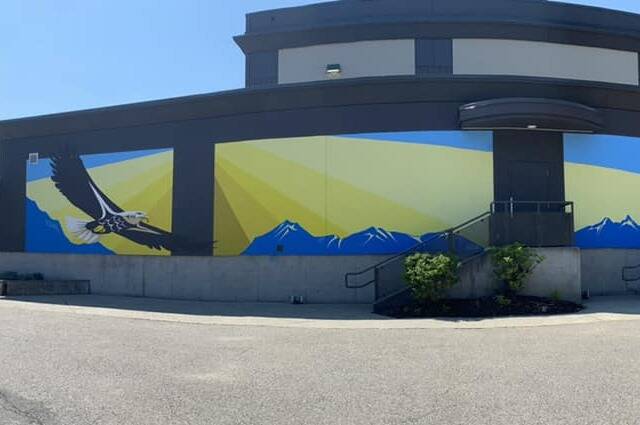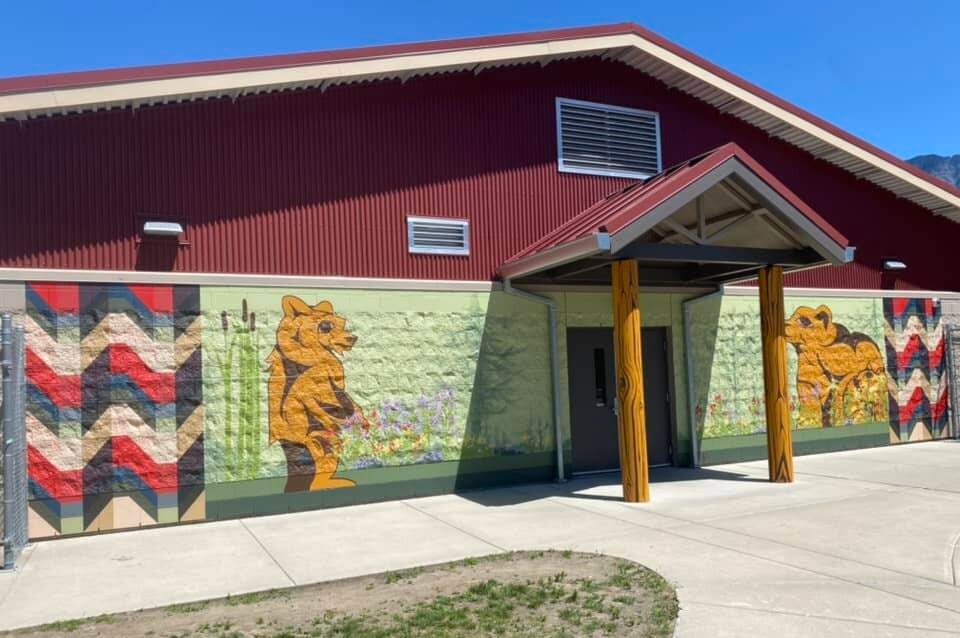Fraser-Cascade students and community members have no doubt noticed new, head-turning art in their communities.
Coast Salish artist Carrielynn Victor (Xémontalot) recently completed four murals – two in Agassiz and two in Hope – themed around local nature and a traditional-modern fusion of Indigenous art. The murals are part of an initiative that took root more than a year ago when a delegation from the school district approached Hope’s district council about incorporating more Indigenous art in the community.
Much of the art in the heart of Hope reflects chainsaw carvings and celebrates the colonial, logging roots of the district, but SD78 officials felt there was a significant, missing piece.
“Although Hope has a strong Indigenous influence with 40 percent of the community being of Indigenous ancestry, we saw that there was a lack of visual representation and that we challenged the council,” said SD78 superintendent Balan Moorthy.
Victor said her work pushes beyond the boundaries of the Coast Salish traditional style and embraces more modern art and area wildlife, such as bears and different species of salmon who call the area home.
“Our people need to evolve. Art needs to evolve. And there’s conflict,” Victor said. ” Do we evolve to reflect other coastal styles? Do we stay true to our unique design style? I don’t have the answers to those questions, but they’re important to talk about.”
The Coquihalla Elementary School mural features grizzly bears and alpine meadow flowers.
“I thought of how important it is to look forward to what we wish to see,” Victor said. “And in this case, we wish to see a healthy grizzly bear population. They’re a keystone species.”
Silver Creek Elementary’s mural represents the life cycle of the salmon. Kent Elementary’s mural features sunshine, a blue sky, salmon and woven patterns.
Agassiz Elementary Secondary School’s mural depicts an eagle soaring above the lands and waters of the Pilalt people.
“The mountains are not only geographic wayfinding points, but they’re also story-rich,” Victor said. “A story-rich landscape will tell us where we fit in the world. The shapes of the (mural’s) mountains to encourage us to look back out into the mountains around us.”
The piece is called “pélawtxw medicine bowl,” referring to the mountains forming a “ medicine bowl” around the Agassiz area.
Throughout the process, Victor got questions about expanding the murals to cover more of the building and what buildings could be next to receive art.
“People feel kind of invested,” she said. “Kids are really interested in the process, adults are interested in the content, and they all felt like they were right in there.”
Painting in Agassiz and Hope was a more unique experience for Victor.
“I’ve painted in Vancouver, and it’s kind of crazy how often they come right up to you,” she said. “In Chilliwack, they come right up to you, but in Agassiz and Hope, they walked by and they talk about you. There’s a bit of apprehension to approach.”
When people did approach, Victor was happy to engage, despite being busy with her work.
“The people who did stop or go out of their way to say hello really touched me,” she said. “I want for this work to soften that (apprehension) a little bit. It’s difficult on both sides. It’s such a human thing. I hope some healthy conversations come from (the murals).”
As for what’s next, Victor has murals booked into next year.
“I’m looking to the sky and the stars for inspiration in my in my coming work,” she said. “And of course the language is intrinsically tied to to that work. What are our ancestral understandings of the sky and how does that connect to us and then to where we fit in, not just in the world but in the galaxy, too?”
The work of Indigenous art on a local level and beyond runs deeper than the art itself; it’s part of an evolving identity. On a school district level throughout the province, there’s an ongoing effort to integrate the teachings of First Nations communities to better represent Indigenous people.
“We want to celebrate the beauty of Indigenous culture and the history and language,” Moorthy said. “Truth and Reconciliation is also about hope.”
In terms of how the Indigenous identity is going to look in the near future, that vision is just beginning to crystallize, thanks in no small part to the art community.
“People didn’t know the true dark history in Canada, around residential schools,” said Christine Seymour (Selisiye), the district’s principal of Indigenous education. “For too long, our people were told who we are and who we’re not. I really think increasing representation in the community really helps us realize our own identity as well.”
“We’re not the impacts of residential school,” Seymour added. “We’re not that alcoholism and we’re not the suicide rates, and we’re not the struggles that our communities have. I’ve watched Carrielynn move through the towns and communities, and I’m always left feeling like I am a little bit taller. My hope for the kids is that they do, too.”

